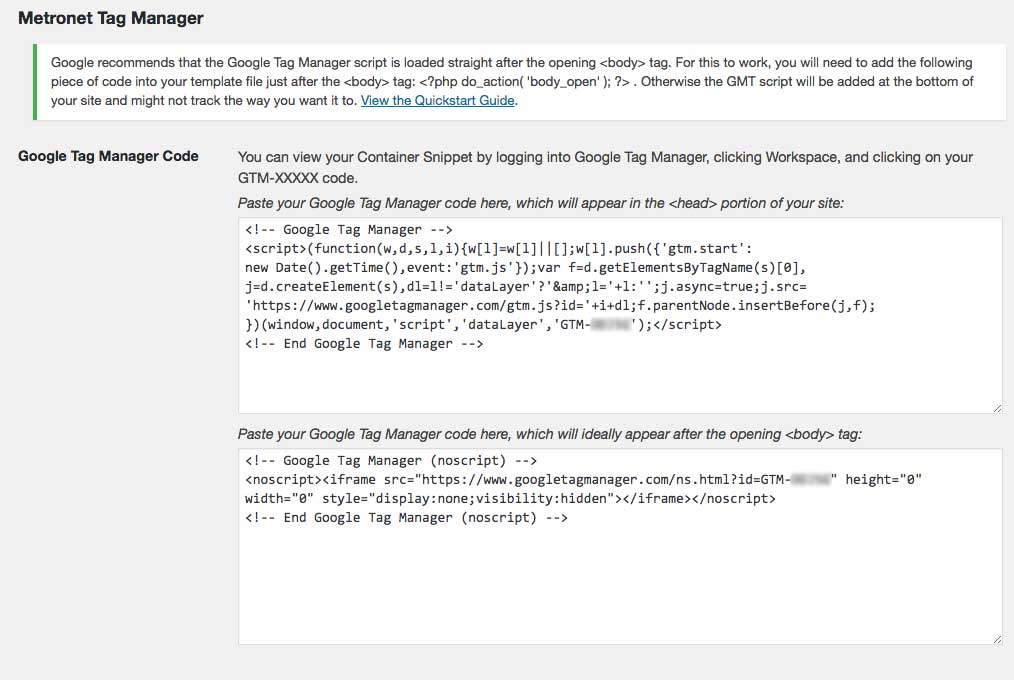
Metronet Tag Manager
| Developer |
ronalfy
pereirinha ruskinconsulting |
|---|---|
| Update Time | Sept. 3, 2023, 12:20 a.m. |
| Donation URL: | donation |
| PHP Version: | 3.9 + |
| WordPress Version: | 6.3.1 |
| Copyright: | GPLv2 or later |
| Copyright URL: | Copyright Information |
Description:
Integrate Google Tag Manager into your website.
The great thing about Google Tag Manager (GTM) is that you are able to gather most of your tracking scripts in one place. You can then fire these scripts whenever you want, specified by the rules you set up. This sounds great, right? Well, it is. The only problem is that sometimes it takes some time to set these rules up. This implementation can either set a dataLayer variable in the dataLayer before the tag manager script is loaded or push an HTML event handler with the variable "event" to the dataLayer when a button is clicked. The problem is that this isn’t always that easy to do when you don’t have the ability/access to add the code to your site.
This is where the Metronet Tag Manager plugin shines. It unlocks the power of the dataLayer so you can easily set macros and firing rules on almost any element.
This plugin lets you:
- Easily add as many dataLayer variables per-post and per-page basis as needed.
- The plugin already gives you six predefined dataLayer variables you can change/remove or test the system with. These will be loaded on all pages and posts.
- Set up separate dataLayer variables for pages that aren’t posts or pages (like archives, etc).
- Lets you easily add an HTML event handler to any content link with the GTM TinyMCE button in the WYSIWYG.
- Lets you add your unique ID or a class to each content link with the GTM TinyMCE button in the WYSIWYG.
<?php do_action( 'body_open' ); ?> just after the <body> tag, and that’s it.
Note, If you are using WordPress 5.2. and up, contact your theme developer and ask them to insert <?php wp_body_open(); ?> just after the opening body tag of their theme. Here is some code to show the theme developer to make it compatible with Metronet Tag Manager.
Please let us know if you have any feature requests or issues with this plugin.
Below are a couple of resources you might find valuable if you are new to Google Tag Manager
Official Google Tag Manager website
https://developers.google.com/tag-manager/
Tracking Google Analytics Events with Google Tag Manager
http://moz.com/ugc/tracking-google-analytics-events-with-google-tag-manager
Make Analytics Better with Tag Management and a Data Layer
http://cutroni.com/blog/2012/05/14/make-analytics-better-with-tag-management-and-a-data-layer/
Installation:
- Just unzip and upload the "metronet-tag-manager" folder to your '/wp-content/plugins/' directory
- 通过 WordPress 的“插件”菜单激活插件
- Modify your theme's
header.phpto include<?php do_action( 'body_open' ); ?>right after the opening<body>tag. - Go to the plugin's settings and input your Google Tag Manager data.
Note: if you are using WordPress 5.2. and up, contact your theme developer and ask them to insert <?php wp_body_open(); ?> just after the opening body tag of their theme. Here is some code to show the theme developer to make it compatible with Metronet Tag Manager.
For custom values, please see the filters section on GitHub.Screenshots:
FAQs:
What is Google Tag Manager
Please refer to the Google Tag Manager FAQ.
What are dataLayer variables?
Please refer to the Google Tag Manager API reference.
What are dataLayer variables used for?
The data layer is an object that contains the information that you want to pass to Google Tag Manager. By setting up rules in Google Tag Manager, these variables can then be used to include the correct snippets or scripts – for example, when a certain button is clicked.
Can I have dynamic values?
Yes. For custom values, please see the filters section on GitHub.
Changelog:
1.5.5
- Released 2023-06-24
- Adding the ability to update header messages remotely.
- Released 2019-07-16
- Adding GTM dataLayer on search pages.
- Released 2019-07-16
- Added Beaver Builder compatibility.
- Released 2019-05-24
- Updating documentation.
- Adding option to hide GTM data layer settings on posts/pages.
- Released 2019-05-21
- Added support for WordPress 5.2's wp_body_open tag.
- Released 2018-11-24
- Added Gutenberg inline option for setting a dataLayer variable
- Released 2018-07-25
- Fixed a bug when saving and outputting Google Tag Manager snippets where an ampersand HTML entity was added to the output.
- Released 2018-04-24
- Fixed serious security issue. Please Update.
- Released 2017-11-15
- Fixing issues in the admin where HTML elements were escaped accidentally.
- Updated 2017-08-10
- Adding style element support
- Updated 2017-05-02
- Code cleanup and remediation by 10up
- Updated 2016-11-08
- Able to adhere to the new tag recommendations of inserting tag markup in the header and also after the body tag
- Updated 2016-04-08
- Improved sanitization for custom values
- Added support for CloudFlare arguments in GTM code
- Prevent non-filtered custom value from being outputted in the dataLayer
- Updated 2016-03-25
- Allow arrays/objects in dataLayer as JSON arguments
- Updated 2015-08-20 - WordPress 4.3
- Released 2015-04-03
- Bug fix - Allow periods in datavariables to comply with GTM 2.0.
- Updated 2014-12-11 - Ensuring WordPress 4.1 compatibility
- Released 2014-09-11
- Fixed anonymous function crashing PHP < 5.3 users
- Released 2014-08-27
- Fixed meta problem with datavariables showing up in areas where there aren't posts or pages
- Ensuring WordPress 4.0 compatibility
- Released 2014-07-08
- Migration to TinyMCE 4
- Translations template
- Released 2013-07-30
- Documentation update
- Released 2013-07-24
- Fixing TinyMCE JavaScript issue
- Initial release.


